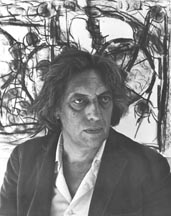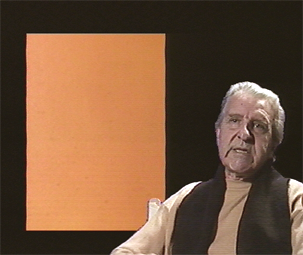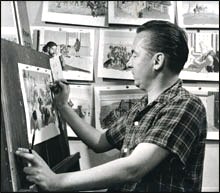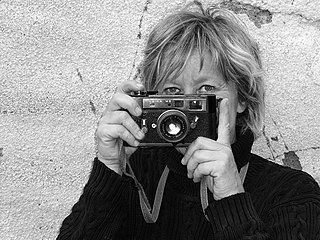Jean-Paul Mousseau was a Quebec artist. He was a student of Paul-Émile Borduas, a member of the Automatist group and a founding member of the Association of Non-Figurative Artists of Montreal.

Jean-Paul Riopelle, was a Canadian painter and sculptor from Quebec. He had one of the longest and most important international careers of the sixteen signatories of the Refus Global, the 1948 manifesto that announced the Quebecois artistic community's refusal of clericalism and provincialism. He is best known for his abstract painting style, in particular his "mosaic" works of the 1950s when he famously abandoned the paintbrush, using only a palette knife to apply paint to canvas, giving his works a distinctive sculptural quality. He became the first Canadian painter since James Wilson Morrice to attain widespread international recognition and high praise, both during his career and after his death. He was a leading artist of French Lyrical Abstraction.

Fernand Leduc was a Canadian abstract expressionist painter and a major figure in the Quebec contemporary art scene in the 1940s and 1950s. During his 50-year career, Leduc participated in many expositions in Canada and France. He was born in Viauville, Montreal, Quebec.

Serge Lemoyne was a Canadian artist from Quebec. He worked as a performance artist as well as creating paintings, assemblages and prints. Lemoyne explored themes such as the environment, technology, and social justice. Lemoyne's work was exhibited in Canada and internationally, and he received numerous awards throughout his career. He died in 1998 at the age of 57.
Geneviève Cadieux is a Canadian artist known for her large-scale photographic and media works in urban settings. She lives in Montreal.
David Blatherwick (born 1960) is a Canadian artist and educator.
Fernand Toupin was a Québécois abstract painter best known as a first-generation member of the avant-garde movement known as Les Plasticiens. Like other members of the group, his shaped paintings drew upon the tradition of geometric abstraction, and he cited Mondrian as a forerunner. In 1959, Toupin began working with a more lyrical, though abstract, way of painting. The last decade of his career saw his return to geometric abstraction. Like Jean-Paul Mousseau, Toupin created works which lay outside the standard boundaries of art such as his stage sets for ballets.

Rita Letendre, LL. D. was a Canadian painter, muralist, and printmaker associated with Les Automatistes and the Plasticiens. She was an Officer of the Order of Canada and a recipient of the Governor General's Award.

Jean-Philippe Dallaire was one of the leading artists working figuratively in the 1960s in Canada. He is known for his festive scenes peopled by macabre characters.
Nancy Petry is a Canadian artist known for innovation within the field of painting, photography, film and performance art. As one of the first Canadian artists to paint in the style of lyrical abstraction, her work was featured at the Commonwealth Institute, at the Musée d'art contemporain de Montréal and in a National Gallery of Canada touring exhibition. She was also instrumental in establishing the Association des graveurs du Québec and contributed to the success of the Montreal alternative art cooperative, Véhicule Art. In 2015 the "Nancy Petry Award" was instituted.
Peter Krausz is a Romanian-born Canadian artist. Throughout his career, he worked within the fields of painting, drawing, installation, and photography and, since 1970, exhibited in museums and galleries across Canada, the United States, and Europe. He is best known for large-scale landscape paintings of the Mediterranean.

Claire Beaugrand-Champagne is a Canadian documentary photographer. She is known for her socially engaged work and, having started her career in 1970, is considered the first female press photographer in Quebec. She was a member of the Groupe d'action photographique (GAP) alongside Michel Campeau, Gabor Szilasi, Roger Charbonneau et Pierre Gaudard
Milly Ristvedt, also known as Milly Ristvedt-Handerek, is a Canadian abstract painter. Ristvedt lives and paints in Ontario, where she is represented by the Oeno Gallery. A monograph covering a ten-year retrospective of her work, Milly Ristvedt-Handerek: Paintings of a Decade, was published by the Agnes Etherington Art Centre in 1979. In 2017, a second monograph was published by Oeno Gallery which included a survey of paintings from 1964 through to 2016, Milly Ristvedt, Colour and Meaning : an incomplete palette.

Jesús Carles de Vilallonga i Rosell was a Spanish/Canadian figurative artist who worked primarily in the medium of egg tempera. He is best known for his richly textured paintings in an intricate, highly colored style that is not easy even though everything is readily intelligible: male and females characters, beasts, forests, architectural structures and artifacts. Vilallonga's iconography draws from a broad and complex painting tradition ranging from Romanesque art, the Renaissance, and Surrealism, while maintaining his own contemporary style. His work is sometimes related to Symbolism and his production is always enhanced by the contributions of abstraction. He works with the "inner eye" which Freud described as the most profound and the most intelligent, in a sojourn through nature and man's hidden interior.
Louise Robert is a Canadian painter who uses writing in her work.
Francine Savard is a Canadian artist whose paintings and installations are grounded in the Plasticien tradition. Her practice explores relationships between language and visual art. Besides painting, Savard has a career as a graphic designer.

Louis Belzile was one of the main figures of geometric abstraction in painting in Quebec and one of the members of the Plasticiens group in Montreal along with Rodolphe de Repentigny (Jauran), Jean-Paul Jérôme and Fernand Toupin.
Roland Poulin is a Canadian contemporary sculptor whose work is characterized by its horizontality and weightiness. He has lived in Sainte-Angèle-de-Monnoir, Quebec, since 1986.
Jean-Paul Jérôme was a painter, designer and sculptor, who was a co-founder of Les Plasticiens in 1955. He was a key figure in Quebec's abstract art scene of the second half of the 20th century.
Rodolphe de Repentigny was a painter, art and literary critic for the newspaper La Presse in Montreal (1952-1959), theorist, photographer and mountaineer. He was a key member of Les Plasticiens and was the writer of the Manifeste des plasticiens. He painted under the pseudonym Jauran.








